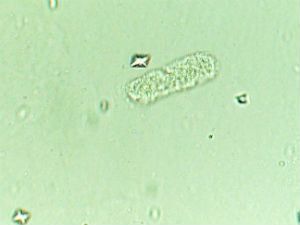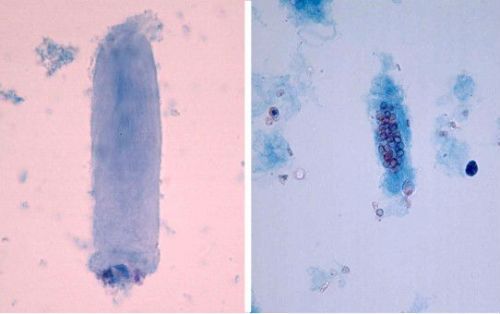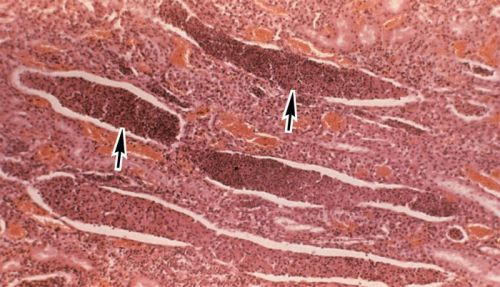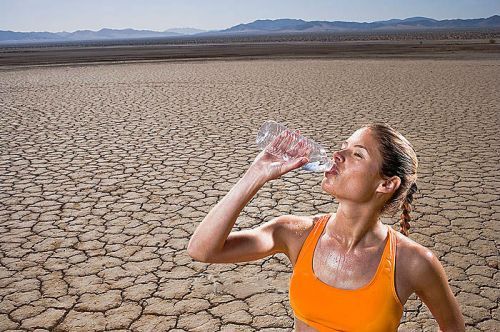Cylinders called similar shape formation in the urine sediment. They are detected by microscopy. In appearance different from any other inclusions. Have their own varieties. One can meet normal, others indicate pathology.
Cylindruria called as urine with a high content of cylinders. Place of education – only renal tubules, so changes in the kidney in medicine is called generic term “tubulopatii”.
Passed through the membrane of the renal glomerulus of substances enter the primary urine in the tubules. Here, the question is what to do with them: ignore and withdraw from the body or to detain and return to the blood. The regulation is carried out by epithelial cells. This process is called reabsorption.
The mechanism of formation of cylinders
The cylinders are casts of substances detained in the tubules.

They are divided:
- the protein – are based on the fall in proteinuria protein in the tubules;
- non-protein – building involves different cellular and biological elements.
For the formation of cylinders in the tubules must be conditions.
- increased throughput of the membrane at its destruction or inflammation (normal protein molecules do not pass through the cracks, because they have a large size);
- the decrease in the rate of movement of urine through the tubules;
- the cessation of absorption of urine.
A slow urine stream is observed:
- in heart failure due to weakness of the myocardium;
- as a consequence of ischemia in atherosclerosis of renal artery;
- when compression of the tubules inflammatory, neoplastic process;
- if the walls of the tubules are inflamed.

Delay unnecessary substances formed with the defeat of the tubular epithelium:
- toxic poisonous substances (poisoning);
- infectious virus (hemorrhagic fever and other conditions with high temperatures);
- some drugs (antibiotics, sulfonamides, Aspirin).
Used to identify different types of coloring
For forming cylinders and coagulation of protein you need:
- high level of proteinuria;
- the acid reaction of urine (in alkaline medium are not formed).
The examples suggest that the cylindruria may be accompanied by not only kidney disease. The state of “stasis” or complete absence of urine flow observed during anuria, due to kidney failure. In phase recovery is increased diuresis, and microscopy in the urine can be seen many cylinders that had the “close up” kanaltsevy passages, and now are pushed into the urine.
The material from which is formed the cylinders, can be judged on the pathological process in the body.
Clinicians are usually distinguished:
- true the cylinders are always built on the basis of protein;
- about – able to be formed from crystals of salts (usually urate), myoglobin in the muscle damage (trauma, surgery), mucus, bacteria.
Each cylinder has its own characteristics of education.
Protein types of cylinders and their characteristics
Among protein structures distinguish hyaline, fibrin and waxy cylinders. Hyaline is composed almost entirely of protein Tamm-Horsfall. Biochemical composition is a glycoprotein located on the surface of the epithelium, but in the event of a change of acidity turns into yarn.
In healthy individuals hyaline formation may be detected not more than 100 in 1 ml of urine:
- in the morning concentrated portions;
- after significant physical activity;
- in a state of dehydration (dehydration).
Observed:
- at high temperature;
- after a bout of congestive heart failure;
- patients who take Furosemide and ethacrynic acid.
For the kidneys, this species is most often encountered. Appears on the background of high proteinuria is a symptom of nephrotic syndrome, indicates the degree of damage of the tubular system, dysfunction of the reabsorption.

As you move through tubules coagulated protein takes the form of the lumen. If the reaction of the urine becomes too acidic, would be destroyed.
The fibrin – named for the main type of protein in the lumen of the tubules, found in hemorrhagic fever with renal syndrome, usually indicate the achievement of maximum destruction. In the recovery of their amount excreted in the urine increases.
Waxy – in contrast to the hyaline formed during prolonged stasis of urine from the structureless primary connections at the death of epithelial cells in the distal tubules. Here the lumen is wider, so waxy cylinders are thicker and shorter than hyaline. The typical yellow coloration, stronger refraction of light, increased density and the definition of a structure.
Often detected in chronic renal disease, rarely in acute glomerulonephritis, tubular necrosis. In healthy individuals always absent. In the diagnostic attitude of the present unfavourable course of the disease, as evidence of atrophy and degeneration of the epithelium, necrotic lesions.
An experienced technician determines the kind of education according to the microscopic picture
Characterization of cell cylinders
The cell cylinders are formed on the basis of the protein with the accession of different elements. They arise in connection with the exudative, hemorrhagic or destructive processes in the nephrons. Therefore, always be considered a sign of kidney damage. The differentiation of individual cell types of cylinders has practical importance in the differential diagnosis of kidney disease.
Erythrocytic (blood) the cylinders are connected with the process of hematuria and glomerular involvement.
Observed:
- with glomerulonephritis;
- interstitial nephritis;
- systemic vasculitis.
- kidney cancer;
- fornicalia the form of a hemorrhage (from the apical part of the pyramid).
Less frequently indicate tubular necrosis, and infarction of the kidney. Neutrophilic leukocyte is characteristic of pyelonephritis (acute or exacerbation of chronic), rarely detected in combination with lymphocytic glomerulonephritis.
Complete the picture of pyuria, bacteriuria. Eosinophil is the most typical for acute druginduced interstitial nephritis.
Epithelial – formed adhesion to the protein matrix of the destroyed epithelial cells, indicative of the destruction of the tubules. Occur in cases of poisoning by corrosive sublimate. Granular – always a sign of organic pathology of the kidneys. They are built of a protein base and destroyed epithelial cells of the proximal tubules (in the form of grains). Coloration darker, the structure striated, grainy.

Revealed:
- nephrotic syndrome;
- pyelonephritis,
- glomerulonephritis.
It is established that the number of granular cylinders is not correlated with the degree of tissue damage the kidneys. For example, when the tuberculosis process is very rare.
Often seen in the combination of epithelial-leukocyte cylinders in acute inflammation of the renal parenchyma, necrosis kanalzeva
The cylinders of the other non-protein entities
In the diagnosis it is important to distinguish under the microscope nonprotein cylinders and to determine their nature. The composition also helps to establish the violation. Fat education is found in nephrotic syndrome of various etiologies.
Pigment cylinders – typical in the clinic, various types gemoglobinurii, they are composed of hemoglobin, therefore, have a brown color.
Meet:
- in reaction to the transfusion of incompatible blood;
- poisoning by nephrotoxic poisons.
Education of the salts indicate a violation of the metabolism, changes in acid-base balance. Dissolved salt falls in crystal precipitate in the tubules and form of education, similar to the cylinders.
From a true cylinder it is necessary to distinguish:
- cylindroid is formed from strands of mucus are rounded one end and extending from the opposite side, may appear in the urine in the stage of outcome of pyelonephritis;
- pseudocylindrical – also are formed from mucus, similar to hyaline cylinders that can include precipitated salts of uric acid, then change the color to a reddish pigment and resemble cylinders.
For cylindruria no characteristic clinical manifestations. All of the symptoms associated with the underlying disease. For the diagnosis it is necessary to consider all violations in the urine. You should be able to distinguish between various types of entities, note that massive cylindruria occurs after restoration of patency of tubules and normalize the outflow.




I discovered your site from Google as well as I have to state it was a terrific find. Many thanks!
Hi there! Such a wonderful post, thank you!
So this post certainly made me think! Thanks-I hadn’t thought of things this way otherwise.
This article includes so much more information than similar blogs, and it’s immensly useful to me. Will be returning to read more writing from you! is it okay to share this?
It’s good to find come across a post like this, that shows the author thinks outside the box! You honestly made me think! Thank You-I wouldn’t have seen things from that angle otherwise. I have to share this…
I have been exploring for a bit for any high-quality articles or blog posts on this sort of area . Exploring in Yahoo I at last stumbled upon this web site. Reading this info So i’m happy to convey that I have a very good uncanny feeling I discovered exactly what I needed. I most certainly will make sure to do not forget this website and give it a look regularly.
These days of austerity in addition to relative stress about taking on debt, many people balk about the idea of using a credit card to make acquisition of merchandise or perhaps pay for a trip, preferring, instead just to rely on the particular tried plus trusted means of making settlement – raw cash. However, if you possess cash on hand to make the purchase in whole, then, paradoxically, that is the best time for you to use the cards for several motives.
This is a very good tips especially to those new to blogosphere, brief and accurate information… Thanks for sharing this one. A must read article.
Great line up. We will be linking to this great article on our site. Keep up the good writing.
Oh my goodness! Awesome article dude! Thank you so much, However I am having troubles with your RSS. I don’t know why I cannot subscribe to it. Is there anyone else getting the same RSS issues? Anyone that knows the solution will you kindly respond? Thanks.
Great web site you’ve got here.. It’s hard to find quality writing like yours these days. I truly appreciate individuals like you! Take care!!
Hi! Someone in my Myspace group shared this website with us so I came to check it out. I’m definitely enjoying the information. I’m book-marking and will be tweeting this to my followers! Outstanding blog and fantastic design.